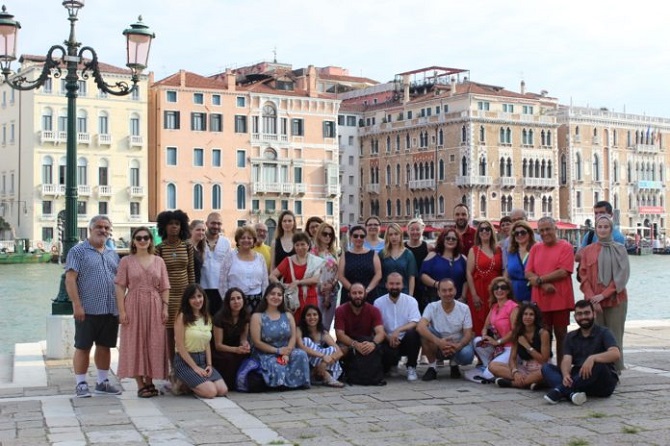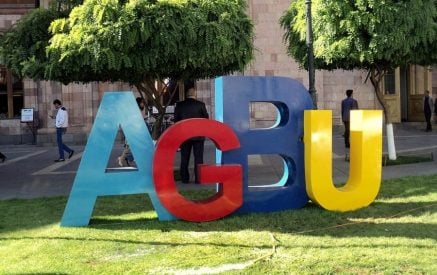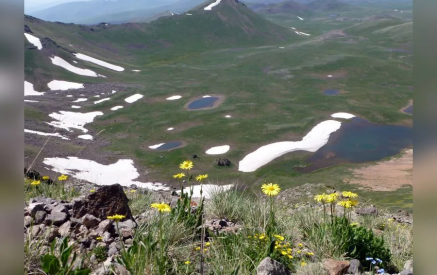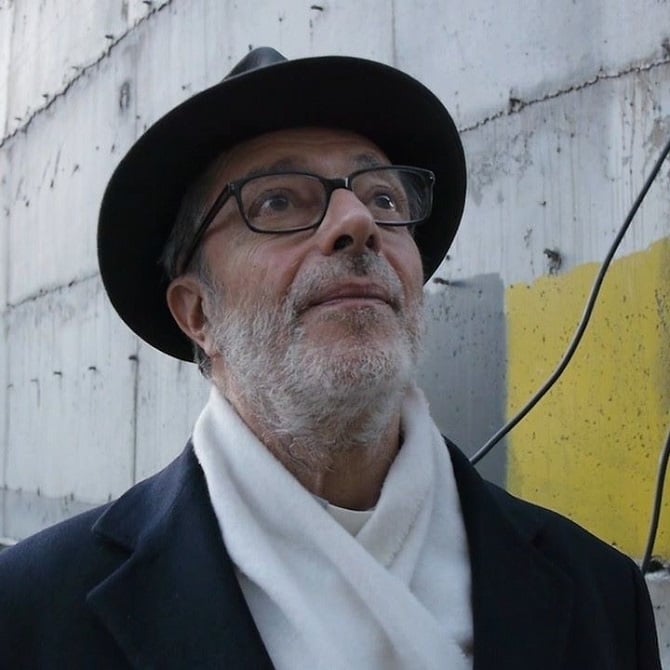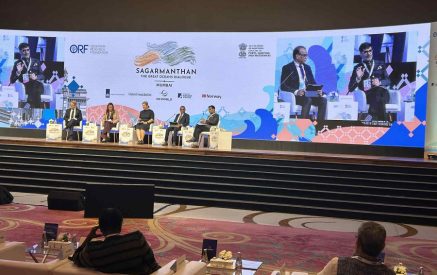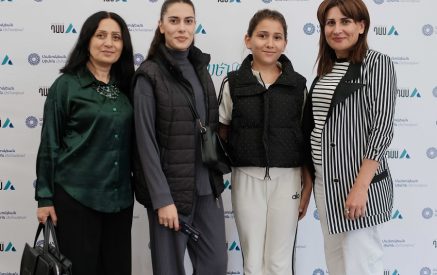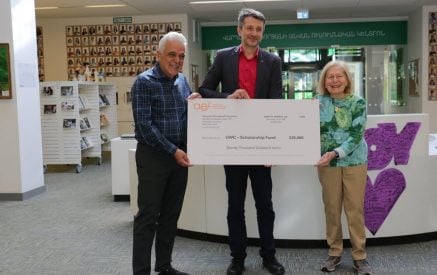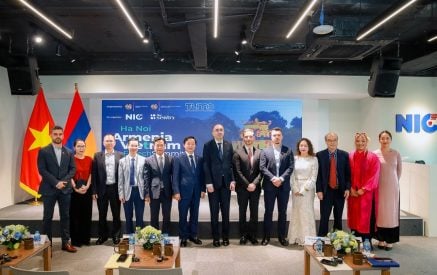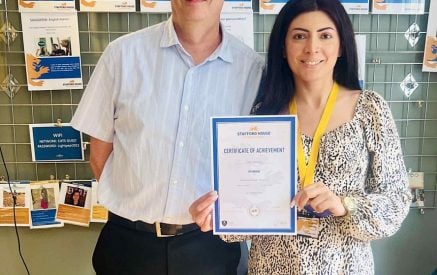The association, founded in 1987 as a charitable non-profit organization for preserving Armenian language, notably its Western form, bears the Latin names of two main rivers of Italy (Po) and Armenia (Arax). Previously it worked under the auspices of the Eurasian Department of the Ca’ Foscari University in Venice, and now independently. It was established by Archbishop Levon Zekiyan, the founder of the Armenian Studies Chair of Ca’ Foscari University, an academician, Armenologist, and philosopher, leader of the Catholic Armenians of Turkey and Papal representative of the Mekhitarist Congregation in Venice.
Mgr. Levon Zekiyan considers Mkhitar Sebastatsi, “a greatness of universal standard” to be the true founder and inspirer of this summer course. The Mekhitarist Congregation of Venice and Moorat Raphael College of Venice (Collegio Armeno) are no longer teaching; however, this intensive summer course continues the Mekhitarists’ message of passing the Armenian spirit and culture to following generations.
The ideology behind this unique course first and foremost is the transfer of Western Armenian language and culture to the new generations of Diaspora Armenians who have often lost their national language. However, the number of non-Armenians attending the course is also not negligible; in fact, some have become academic Armenologists.
For 34 years, from 1986 to 2009, more than 1,400 participants from 36 different countries, of 40 different nationalities, over three quarters of whom were of Armenian descent, have attended this Venetian Course.
Read also
The course is divided into four levels, from absolute beginners to native-speakers. The three-week course offers 65 classes which are held in the historical building of the Patriarchate of Venice, where participants receive their basic knowledge of Armenian language, history and culture, or expand and strengthen what they already know.
Many ask: Why go to Venice in order to study Armenian? No one goes to, let us say, Finland, for studying, let us say, Farsi. But we should bear in mind that the Venetian course teaches the main language of the Diaspora — Western Armenian. Moreover, Venice is geographically convenient, situated in the heart of Europe, being the European city possessing the most Armenian historical traces and a continuous Armenian presence.
The Founder of the Course
The Venice Intensive Summer Course of Armenian Language and Culture is one of the few institutions in the Armenian Diaspora today that, in its mission and commitment, is comparable to the Goethe-Institute in promoting the study of the German language abroad and encouraging international cultural exchange and relations.
However, unlike the Goethe-Institute, the Venetian Course is not supported by any governmental agency and does not have branches in different countries; its teaching staff and participants become a kind of missionaries of the course in their own countries
Many students come back again and again to strengthen what they have already achieved and to live in a miraculous place such as Venice.
Zekiyan’s charisma is no less important. Besides carrying on this difficult organizational work on his shoulders already for 35 years, he manages to produce works in six languages (his scholarly interests include Armenian studies, particularly literature, philology, history, identity, as well as philosophical and theological issues) and participating in international conferences and in almost every Armenian event in Italy (and not only). And every August, his burden increases, as his efforts to improve the course year after year are often compounded by far-reaching educational and sometimes domestic concerns. But Zekiyan succeeds in finding the best solution for every issue. There is always something interesting that he recounts; one always learns something useful from him, as he often lectures especially on the aspects of Armenian identity, an important subject for the Diaspora (and not only), as any Diasporan Armenian sooner or later poses the question: “Who am I?”
The Teachers
Monsignor Zekiyan and many regular attendees attribute a big portion of the course’s success to the teaching staff. Over the past 20 years, the total number of teachers has been around 60 (15 of whom were there only for one year), but in recent years there has been a main core of teaching staff.
Teacher Bared Manok from France, a native of Istanbul, a specialist in Eastern languages, has been teaching in the program for 33 years. Manok conducts classes in Western Armenian, and, when appropriate, also utilizes French, Italian, Turkish, or English for expanded explications.
Raffi Setian from the US, a veteran teacher of English with several master’s degrees and a broad experience in teaching in Europe, Asia, and Africa, is also a poet and translator, and teaches Diasporan-Armenian literature in Armenian and Armenian history in English.
Two teachers, natives of Syria, teach at the first, second, and third levels: Rosine Tachjian-Atamian from France, a teacher in Parisian Armenian schools, is also a soloist at the Armenian Church in Paris and an interpreter of Armenian folk songs; and Sossi Sousanian from Hungary, a graduate of the Department of Armenian Language and Literature at Yerevan State University, teaches Armenian in Budapest and works for the Armenian hour on local radio.
Benedetta Contin Ipekdjian, who currently works in Vienna, impresses all of us with her fluent Armenian. She has been a teacher of classical Armenian for several years and also is the vice-president and treasurer of Padus-Araxes. The teaching of Grabar by an Italian is not something unusual. Benedetta wrote and defended her PhD dissertation on the great Armenian philosopher of the early Middle Ages, David the Invincible.
In addition to teaching the history of Armenian theater, choreography, and cinema at the fourth level, philologist Artsvi Bakhchinyan from Armenia conducts a number of weekly classes for those wishing to learn traditional Armenian dances. Sometimes he also teaches Armenian songs and poems to the third level. Additionally, he also presents feature or documentary films on Armenian topics during the course.
Linguist and Orientalist Tork Dalalyan, also from Yerevan, teaches several subjects: Grabar, Armenian language history, and the methodology of language teaching (Eastern and Western Armenian, correlations between classical and so-called Soviet orthography).
Avedis Hadjian, originally from Syria, a longtime citizen of Argentina, currently residing in Venice, is a teacher of the history of the Armenian press.
Musician Aram Ipekdjian, a native of Aleppo, who studied at the Yerevan State Conservatory, and currently lives between Italy and Austria, offers extracurricular duduk lessons. His exquisite performances on the duduk are enjoyed during the Armenian liturgies and traditional evening parties.
The course has also an administrative staff: the secretary of Padus-Araxes for a long time was Daniela Reato Schiavo. During more recent years, Evelyn Korsch, Nora Elbe, Isabella Abbate, Yesayi Nahapetyan, Husik Hambardzumyan, Eleonora Forte, and Anna Maria Mandracchia have patiently carried out administrative work, taking care of requests of both teachers and attendees.
The Attendees
Among the course participants, aged 18 to 80, the majority are Diasporans; there are also non-Armenians, who just want to learn some Armenian because of personal and professional motivations. Going through the pages of the course’s Commemorative Book, among its participants can find the names of academicians, nowadays playing an important role in Armenian Studies, including Theo Van Lint, Head of the Department of Armenian Studies at Oxford University; Valentina Calzolari, head of the Department of Armenian Studies at the University of Geneva; American linguist Virgil Strohmeier, who taught at the American University of Armenia for a while, as well as Italian Armenologists Giusto Traina, Andrea Scala and others.
Fortunately, many in the diaspora choose an institutionalized way for the Armenian education of new generations, thus cooperating with Venetian Course. For several years the board of the Romanian-Armenian community has sent its most active youth to Venice, while the Bureau of Armenian Teachers of Istanbul, for the sixth consecutive year, has sent young teachers for increasing their knowledge. The former principal of the Kololian Armenian College of Toronto, Armen Martirossian, brought a dozen of the school’s graduating students seven consecutive years to Venice; those students always made a happy addition to our program with their knowledge of Armenian language and family roots. In addition, the newly-ordained candidates for the Mekhitarist Congregation, originally from the Republic of Armenia and Javakhk, have participated in the course twice.
Of course, one does not learn a language in only three weeks. However, the participants lay the foundation for language proficiency, which can be increased by ongoing self-improvement. At the end of the intensive course, participants not knowing any Armenian three weeks before, are quite delighted because they already understand simple Armenian sentences and can express thoughts of their own in simple sentences.
In addition to learning a language, many Armenians are driven by the desire to live in an Armenian environment. For an Armenian, isolated from a native context year round, the program provides an opportunity to speak, read, write, breathe, laugh in Armenian for about 20 days. Almost everyone’s lives and personal experiences are interesting to hear about. These people of Armenian origin, often born of non-Armenian fathers or mothers, having double or triple identities, remember and embrace their roots.
In recent years, the Venice courses have also been attended by Armenians from Armenia. I should explain to those who are skeptical of this fact: most Armenians in Armenia today are unfamiliar with the Western Armenian language and literature, not to mention classical orthography and Grabar or the history of Armenian art. It is also an exceptional opportunity to meet many Diasporan Armenians in one place.
Various Activities
The program is, in fact, quite full. In addition to extracurricular dance and duduk classes and film screenings, various lectures are presented by participants or guest lecturers. A valuable experience is visiting the Armenian sites of Venice, which number more than 50! In addition to the Mekhitarist-related sights, one can see in San Salvador church the tomb of the Venetian princess Catherine Cornaro, who was the last person to bear the title of Queen of Armenia; one can stroll along the Ruga Giuffa (Julfa Street); and one can view the bronze statues of four horses on the roof of St Mark’s Basilica, which are traditionally considered as presents from the Armenian King Trdat I to the Roman Emperor Nero… Let’s add the Armenian pavilions of Venice Biennale and remember again that in 2015 the Golden Lion for the national pavilion went to Republic of Armenia’s pavilion named “Armenity,” based on Diasporan artists’ works…
It has become a beautiful tradition to compose a choir of teachers and students of the course and sing Holy Mass in the Holy Cross Armenian Church and on the feast of the Assumption of Mary in the Armenian Cathedral of St. Lazar (San Lazzaro) Island. After the feast of the Assumption and traditional blessing of grapes, the Mekhitarist fathers hold a reception for the guests in the adjacent garden; and Armenian songs, dances, and games make the monastery lively for a couple of hours.
And once each week there are evening parties, which take place in the dormitory’s yard, during which many of the participants show off their artistic skills – singing and reciting in different languages, dancing, playing instruments, telling jokes or performing small sketches in Armenian.
On the last days of the course most of the attendees prepare for the exams with diligence and commitment. Those who succeed in the oral and written exams later receive a certificate.
‘We are leaving with strengthened Armenian identity…’
A unique atmosphere, warm relations, enthusiasm for the Armenian language and culture, are created during those three weeks. The attendees not only lay a foundation for their Armenian or improve their language and cultural knowledge, but also gain an unparalleled experience of human and intercultural communication in an aesthetic Italian reality. As a participant once observed: “At first we were acquaintances, then we became friends, and at the end we became a family.”
The days fly by very fast, and the moment of farewell arrives too soon. It is not easy to take leave from the people with whom you shared a wonderful experience in a fabulous atmosphere. Some people cannot hold back their tears, and some joke: “Never mind, one year until we meet again…” And, indeed, many know that they will return to continue and develop what they have achieved, or reappear in that unique and unusual ambiance. Some say they are leaving with a strengthened Armenian identity and are more determined to devote themselves to everything Armenian, while others say they will correspond with each other only in Armenian, meet in Armenia or in an Armenian-populated place. In our age of fast communication, in a “reduced” planet, keeping up precious friendships is not difficult if there is a will — especially if that friendship is bound by the common interest and love that is called the Armenian language and Armenian culture.
Thus, such initiatives make it possible to preserve our identity and to maintain the “Armenian drop” in the whirlpool of mankind’s deepest ocean.
But the lessons go beyond of Armenian interests… As Mgr Zekiyan once said: “Last year, when I asked one of our participants, a young Polish lady, what she learned here besides Armenian, she answered: ‘Humanity.’ This is an exciting and important assessment, indeed…”
Former Venice Course attendees speak
Dr. Vartan Matiossian (Argentina, currently in the US, participant in 1987): “Thirty-three years ago, my attendance in the course had a formative impact on me, since it was my first trip abroad and my first living contact with Armenian Studies, especially history and literature, with scholars like Raymond Kevorkian and Marc Nichanian as my teachers, and the continuous presence and talks with Mgr Zekiyan. I was also fortunate enough to share my days with a wonderful group, still remembered as the ‘group of ’87’ many years later. Above all, it was Venice…”
Karen Hamada (Japan, participant in 2012): “On my arrival at Venice in the year 1816, I found my mind in a state which required study.” As Lord Byron writes in his memoirs, the summer I spent in Venice made up my mind to study more about Armenian culture and history. For me, a non-Armenian Armenologist, it was really a valuable opportunity to learn Western Armenian with skilled teachers, visit the Armenian heritages of the city. And, the thing that motivated me most was the people I met there – teachers, staffs, participants, and monks of the San Lazzaro, who welcomed and helped my research. I still remember and will never forget the days that changed my life.”
Arif Tapan (Turkey, participant in 2015-2016,): “I attended the course in Venice twice since I am an academic researching on Ottoman-Armenian literature and especially Armeno-Turkish literary texts. My aim was to improve my Western Armenian. But within a few days I realized that this course gives the participants more opportunities than learning Armenian. I had the opportunity to exchange ideas with participants from all over the world, and to meet very competent and sincere instructors in teaching Armenian. In addition to learning Armenian, I had the opportunity to get to know Armenian culture and history more closely. It was a great experience for me to attend this course in Venice, a city that is unique in terms of culture, art and history.”
Polina Ivanova (Russia, currently in Armenia, participant in 2013): “The program, which brought together teachers and students from Armenia, Turkey, the US, France, and many other places, was like a microcosm of the Armenian-speaking world itself with its diversity and paradoxes. And there is nothing like studying Armenian in Venice – perhaps the most important center of Armenian scholarship. It gives every participant a subtle link to the great tradition established by the Mekhitarists three centuries ago.”
Vahan Saghdejian (Syria, currently in Lebanon, participant in 2019): “I feel so blessed that I had the chance to join the Padus-Araxes Cultural Association summer intensive course. It was one of my best experiences. There are so many social, cultural and academic benefits that I gained from this course. I also had the chance to see world’s most artistic and unusual place — The city of dreams, Venice…”
Sharneil Laureen Lewis (Caribbean Islands, currently in Italy, participant in 2019): “I found the Venice Armenian Studies program to be a real insight into the culture and language of Armenia with an authentic and hands on experience second to no other program. The classes are very informative, well structured and student friendly, also the program was very vibrant and fun catering to our younger generation in the sense that, the language courses, were always organized with extracurricular activities including music, dance and excursions, which never left you bored; there was always somewhere to see and to go. It was definitely always fun to converse with the ever-friendly and vibrant Armenian students and teachers, from all over the world and get hands on experience of their culture. The teachers were some of the most professional and experienced that I have ever met, they definitely made the classes easier by their patience and dedication to their students, and ways of making the language more at ease, and readily learnable to everyone with a variety of interesting and fun teaching strategies. In all, I found the program to be a very good experience, and I hope to continue learning Armenian.”
For those interested to attend the Summer Intensive Course of Armenian Language and Culture can visit http://www.padus-araxes.com/en/press-release/
Special to the Mirror-Spectator
Main photo: A group of students and teachers in Venice, with the author, Artsvi Bakhchinyan, on the first row, fourth from right




















































